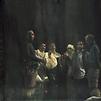: From "bourgeois gentilhomme" to "bourgeois artiste"
A couple, provincial notables who love and perform baroque theatre and music as amateurs. Mistaken identities and misunderstandings of all kinds in a Molière-style farce about "distinction" and art as "higher-mindedness".
From "bourgeois gentilhomme" to "bourgeois artiste", little by little the social satire increases and borrows from the carnival tradition.
Here, farce and the grotesque are given their full measure:
the desire to work on everything that is repressed by "official" culture, by the prevailing "culturally correct and unequivocal". Farce, the grotesque, carnival, darkness and lightness.
The "gélodacrye" of the Renaissance: it's about being able to cry or to laugh, or to cry and laugh at the same time. The carnival language which Bakhtine speaks to us about regarding Rabelais, language "marked in particular by the original logic of things "upside down", on the "contrary", constant permutations of up and down (the "wheel"), in front and behind, the most varied forms of parodies and travesties, debasements, defilements and comical crownings and dethronements.
The play can be divided into three movements, corresponding to disorder, order and to something in the order of catastrophe (or dream, somewhere between reality and nightmare).
Part one corresponds to a first space with the backdrop on the floor, which also forms a small castle, behind which Etienne is getting ready. He "appears" (for he's really an apparition) perhaps at the moment of Sophie's entrance, or during the "Chanson de l'Habit". His costume is absolutely "un-take-out-able". There is "ghost furniture", perhaps with things placed on them, elements which can be taken away during the playing, except one which perhaps "rises" with the backdrop. Also, there is in particular this bookshelf which later will find itself up high, with objects balanced on it, and with chairs attached which will be retrieved with a long handyman's pole later in Part two.
But now, with the backdrop raised, this appears somewhat impracticable. There is a ladder at one end of the bookshelf, but it only allows a tiny end of the shelf to be reached.
At one moment, the bookshelf falls, or something falls off, even something very light or small, a feather, but which conveys the idea that rest could fall too.
Colour : there is always this idea of "black and white", thus all shades of grey, and also perhaps "blackboard green" (a colour painted with traces of something which has run), on which the colours of the costumes stand out.
For Part three, there will be the idea that the backdrop will open and behind there'll be a small hall of mirrors, or nothing, or ... (with an interesting effect of mirrors and light, to give an impression of transparency when in fact it is a reflection).
The characters of Sophie and Etienne are dishevelled, they dance their chicken-like ballet, their makeup has run, Bernadette is wearing rubber boots.
By way of accessories, there are buckets and mops, and perhaps water to "clean" with. There is almost no more music, apart from the noise of steps on the floor and the final song. There is also the space "around", and the plank between two ladders for the musicians (all this on casters?).
Eugène Durif and Catherine Beau
Ces fonctionnalités sont réservées aux abonnés
Déjà abonné,
Je me connecte
–
Voir un exemple
–
Je m'abonne
Ces documents sont à votre disposition pour un usage privé.
Si vous souhaitez utiliser des contenus, vous devez prendre contact avec la structure ou l'auteur qui a mis à disposition le document pour en vérifier les conditions d'utilisation.


